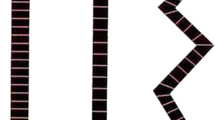Abstract
The lateral rectus (LR) muscle of the pigeon was directly stimulated in situ at 41°C. The length tension relationships for active and passive tension were investigated to determine the optimum muscle length (Lo). Isometric responses to single and twin pulses, tetani and sinusoidal stimulation were measured
A linear relationship was found between length and active tension during stimulation. Increase in stimulation frequency produced a corresponding shift in tension with the slope of the curves remaining the same. At Lo (1.21 times resting length) the average contraction time of single twitches was 6.03 ms and the half-relaxation time was 7.77 ms. Stimulation frequencies of 200 Hz and over gave rise to a fused tetanus. Tension increased to a maximum at 200 Hz and rate of tension rise saturated at 600 Hz. The ension response to tetanic stimulation was linear over the range 70–180 Hz. Maximum tetanic tension was around 3.48 N/cm2 and the twitch: tetanus ratio was 0.164. Prolonged activation at fusion frequency showed a high fatigue resistance. Sinusoidal stimulation with pulse trains of 100–180 Hz produced a sinusoidal response over the frequency range 0.6–40 Hz, from which the gain and phase relation-ships were determined. The muscle response approximates a first order low pass filter, with a characteristic frequency of 11.2 Hz. There is an additional phase lag, equivalent to the response latency, of 2.89 ms. The results are compared to the contractile properties of mammalian eye and avian skeletal muscle. The frequency response of the LR is compared to that of cat soleus and gastrocnemius and to pigeon eye movement dynamics.
Similar content being viewed by others
References
Alvarado J, Van Horn C (1975) Muscle cell types of the cat inferior oblique. In: Lennerstrand G, Bach-Y-Rita P (eds) Basic mechanisms of ocular motility and their clinical implications. Pergamon, Oxford, pp 15–43
Alvarado-Mallart R-M (1972) Ultrastructure of muscle fibres of an extraocular muscle of the pigeon. Tissue Cell 4:327–339
Asmussen G, Gaunitz U (1981) Mechanical properties of the isolated inferior oblique muscle of the rabbit. Pflügers Arch 392:183–190
Bach-Y-Rita P, Ito F (1966) In vivo studies in fast and slow muscle fibres in the cat. J Gen Physiol 49:1177–1198
Barmack NH (1976) Measurements of stiffness of extraocular muscles of the rabbit. J Neurophysiol 39:1009–1919
Blakemore C, Donaghy M (1980) Coordination of head and eyes in the gaze changing behaviour in cats. J Physiol 300:317–335
Bloch S, Martinoya C, Rivaud S (1981) Eye movements in pigeons: participation in binocular fixation and visual pursuit. J Physiol 320:20P-21P
Bloch S, Rivaud S, Martinoya C (1984) Comparing frontal and lateral viewing in the pigeon. III. Different patterns of eye movements for bibocular and monocular fixation. Behav Brain Res 13:173–182
Browne JS (1976) The contractile properties of slow muscle fibres in the sheep extraocular muscle. J Physiol 254:533–550
Buchtal F (1961) The general concept of the motor unit. ANMD Research Proceedings 38:3–30
Cheng-Minoda K, Davidowitz J, Liebowitz A, Brennin GM (1968) Fine structure of extraocular muscle in rabbit. J Cell Biol 39:193–197
Close RI (1972) Dynamic properties of mammalian skeletal muscles. Physiol Rev 52:129–197
Close RI, Luff AR (1974) Dynamic properties of the inferior rectus muscle of the rat. J Physiol 236:259–270
Fite KV (1978) Optokinetic nystagmus and the pigeon visual system. In: Granada AM, Maxwell JH (eds) Neural mechanisms of behaviour in the pigeon. Plenum Press, New York, pp 395–407
Friedman MB (1975) How birds use their eyes. In: Wright P, Caryl PG, Vowles D (eds) Neural and endocrine aspects of behaviour in birds. Elsevier, Amsterdam Oxford New York, pp 181–204
Fuchs AF, Luschei ES (1971) Development of isometric tension in simian extraocular muscle. J Physiol 219:15–161
Ginsborg GL (1960) Spontaneous activity in muscle fibres of the chick. J Physiol 150:707–717
Hess A, Pilar G (1963) Slow fibres in the extraocular muscles of the cat. J Physiol 169:780–799
Kaczmarski F (1970) The fine structure of the extraocular muscles of the tree sparrow,Passer montanus L. Z Mikrosk Anat Forsch 82:523–536
Kikuchi T, Schmidt H (1983) Changes in resting and contractile properties of chicken muscles following denervation. Biomed Res 4 (3):303–314
Lennerstrand G (1975) Motor units in eye muscles. In: Lennerstrand G, Bach-Y-Rita P (eds) Basic mechanisms of ocular motility and their clinical implications. Pergamon Press, Oxford, pp 119–141
Maier A (1981) Characteristics of pigeon gastrocnemius and its muscle spindle supply. Exp Neurol 74:892–906
Maier A, Eldred E, Edgerton R (1972) Types of muscle fibres in the extraocular muscles of birds. Exp Eye Res 13:255–265
Martinoya C, le Houezec J, Bloch S (1984) Pigeon's eyes converge during feeding: evidence for frontal binocular fixation in a lateral eyed bird. Neurosci Lett 45:335–339
Mayr R (1971) Structure and distribution of fibre types in the external eye muscles of the rat. Tissue Cell 3:433–462
McVean A, Stelling J (1986) The mechanics of pigeon eye movements — are the like other vertebrates? Behav Brain Res 19:117–121
McVean A, Stelling J, Rowlerson A (1987) Muscle fibre types in the external eye muscles of the pigeon (Columba livia). J Anat 154:91–101
Nye PW (1969) The monocular eye movements of the pigeon. Vision Res 9:133–144
Page SG (1969) Structure and some contractile properties of fast and slow muscles of the chicken. J Physiol 205:131–145
Partridge LD (1965) Modification of neural output signals by muscles: a frequency response study. J Appl Physiol 20:150–156
Robinson DA (1964) The mechanics of human saccardic eye movement. J Physiol 174:245–264
Wallman J, Velez J, Wienstein B, Green AE (1982) Avian vestibuloocular reflex: adaptive plasticity and developmental changes. J Neurophysiol 48:952–967
Zuber BL (1968) Sinusoidal eye movements from brainstem stimulation in the cat. Vision Res 8:1073–1079
Author information
Authors and Affiliations
Rights and permissions
About this article
Cite this article
Stelling, J., Mc Vean, A. The contractile properties and movement dynamics of pigeon eye muscle. Pflugers Arch. 412, 314–321 (1988). https://doi.org/10.1007/BF00582514
Received:
Revised:
Accepted:
Issue Date:
DOI: https://doi.org/10.1007/BF00582514



